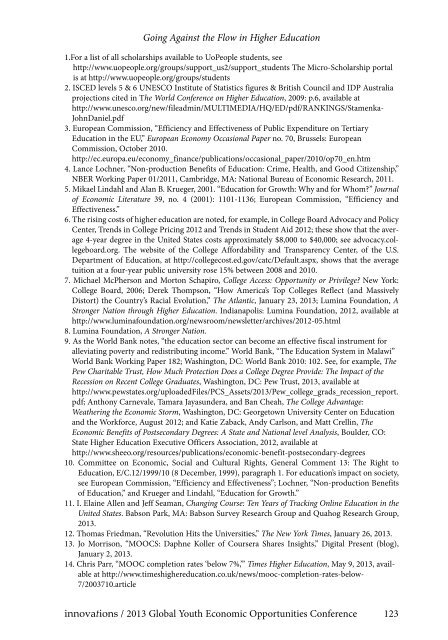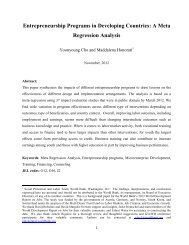Download - Youth Economic Opportunities
Download - Youth Economic Opportunities
Download - Youth Economic Opportunities
Create successful ePaper yourself
Turn your PDF publications into a flip-book with our unique Google optimized e-Paper software.
Going Against the Flow in Higher Education<br />
1.For a list of all scholarships available to UoPeople students, see<br />
http://www.uopeople.org/groups/support_us2/support_students The Micro-Scholarship portal<br />
is at http://www.uopeople.org/groups/students<br />
2. ISCED levels 5 & 6 UNESCO Institute of Statistics figures & British Council and IDP Australia<br />
projections cited in The World Conference on Higher Education, 2009: p.6, available at<br />
http://www.unesco.org/new/fileadmin/MULTIMEDIA/HQ/ED/pdf/RANKINGS/Stamenka-<br />
JohnDaniel.pdf<br />
3. European Commission, “Efficiency and Effectiveness of Public Expenditure on Tertiary<br />
Education in the EU,” European Economy Occasional Paper no. 70, Brussels: European<br />
Commission, October 2010.<br />
http://ec.europa.eu/economy_finance/publications/occasional_paper/2010/op70_en.htm<br />
4. Lance Lochner, “Non-production Benefits of Education: Crime, Health, and Good Citizenship,”<br />
NBER Working Paper 01/2011, Cambridge, MA: National Bureau of <strong>Economic</strong> Research, 2011.<br />
5. Mikael Lindahl and Alan B. Krueger, 2001. “Education for Growth: Why and for Whom” Journal<br />
of <strong>Economic</strong> Literature 39, no. 4 (2001): 1101-1136; European Commission, “Efficiency and<br />
Effectiveness.”<br />
6. The rising costs of higher education are noted, for example, in College Board Advocacy and Policy<br />
Center, Trends in College Pricing 2012 and Trends in Student Aid 2012; these show that the average<br />
4-year degree in the United States costs approximately $8,000 to $40,000; see advocacy.collegeboard.org.<br />
The website of the College Affordability and Transparency Center, of the U.S.<br />
Department of Education, at http://collegecost.ed.gov/catc/Default.aspx, shows that the average<br />
tuition at a four-year public university rose 15% between 2008 and 2010.<br />
7. Michael McPherson and Morton Schapiro, College Access: Opportunity or Privilege New York:<br />
College Board, 2006; Derek Thompson, “How America’s Top Colleges Reflect (and Massively<br />
Distort) the Country’s Racial Evolution,” The Atlantic, January 23, 2013; Lumina Foundation, A<br />
Stronger Nation through Higher Education. Indianapolis: Lumina Foundation, 2012, available at<br />
http://www.luminafoundation.org/newsroom/newsletter/archives/2012-05.html<br />
8. Lumina Foundation, A Stronger Nation.<br />
9. As the World Bank notes, “the education sector can become an effective fiscal instrument for<br />
alleviating poverty and redistributing income.” World Bank, “The Education System in Malawi”<br />
World Bank Working Paper 182; Washington, DC: World Bank 2010: 102. See, for example, The<br />
Pew Charitable Trust, How Much Protection Does a College Degree Provide: The Impact of the<br />
Recession on Recent College Graduates, Washington, DC: Pew Trust, 2013, available at<br />
http://www.pewstates.org/uploadedFiles/PCS_Assets/2013/Pew_college_grads_recession_report.<br />
pdf; Anthony Carnevale, Tamara Jayasundera, and Ban Cheah, The College Advantage:<br />
Weathering the <strong>Economic</strong> Storm, Washington, DC: Georgetown University Center on Education<br />
and the Workforce, August 2012; and Katie Zaback, Andy Carlson, and Matt Crellin, The<br />
<strong>Economic</strong> Benefits of Postsecondary Degrees: A State and National level Analysis, Boulder, CO:<br />
State Higher Education Executive Officers Association, 2012, available at<br />
http://www.sheeo.org/resources/publications/economic-benefit-postsecondary-degrees<br />
10. Committee on <strong>Economic</strong>, Social and Cultural Rights, General Comment 13: The Right to<br />
Education, E/C.12/1999/10 (8 December, 1999), paragraph 1. For education’s impact on society,<br />
see European Commission, “Efficiency and Effectiveness”; Lochner, “Non-production Benefits<br />
of Education,” and Krueger and Lindahl, “Education for Growth.”<br />
11. I. Elaine Allen and Jeff Seaman, Changing Course: Ten Years of Tracking Online Education in the<br />
United States. Babson Park, MA: Babson Survey Research Group and Quahog Research Group,<br />
2013.<br />
12. Thomas Friedman, “Revolution Hits the Universities,” The New York Times, January 26, 2013.<br />
13. Jo Morrison, “MOOCS: Daphne Koller of Coursera Shares Insights,” Digital Present (blog),<br />
January 2, 2013.<br />
14. Chris Parr, “MOOC completion rates ‘below 7%,’” Times Higher Education, May 9, 2013, available<br />
at http://www.timeshighereducation.co.uk/news/mooc-completion-rates-below-<br />
7/2003710.article<br />
innovations / 2013 Global <strong>Youth</strong> <strong>Economic</strong> <strong>Opportunities</strong> Conference 123

















